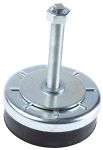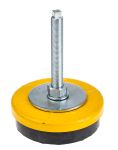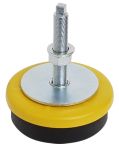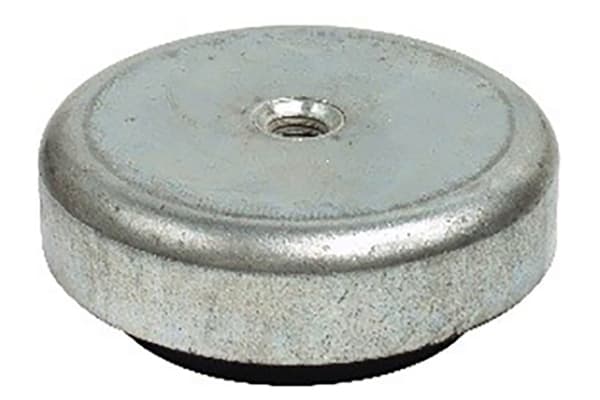Adjustable Feet
Adjustable feet are used for levelling and supporting structures, machinery, furniture and display stands that require vertical adjustments to function correctly. Adjustable feet come in various base sizes and thread sizes to suit different applications. Larger thread sizes and base diameters provide the best weight capabilities in comparison to smaller sizes. The larger the base the better the levelling of stabilisation.RS Components offer an extensive range of products suitable for light-duty and heavy-duty applications. All metal machine feet are ideal for heavy-duty items. The base material can consist of galvanised steel, nickel-plated steel, stainless steel or zinc-plated steel. The footing material can also be manufactured from stainless steel as well as PS reinforced nylon or rubber.What are Adjustable Feet used for?Adjustable feet are used as stability tools in machinery to distribute the weight evenly. They are standard in production environments where conveyor belts are used such as the food manufacturing, pharmaceutical and cosmetics industries. They are also used in the packaging industry where precision alignment and balance levels are required for the special machinery to function.Where can I use Adjustable Feet?Here are just a few good examples of where you can use adjustable feet:When raising furniture or machinery, the adjustable thread offers more height you can add for stability.To level off an object articulating and tilting feet help with un-even surfaces or varying heights.To reduce vibrations and noise – a rubber base foot helps reduce vibrations and noise as rubber provides a great level of shock absorption.When frequent height adjustment is required, feet can be used to help e.g. portable stands and stalls.Types of Adjustable FeetFixed feet – with a rigid base. They can be adjusted vertically, but not sideways. Suitable for general uses.Articulating feet – allow a deviation of up to 8 degrees and are used for balancing structures on uneven surfaces.Tilting feet – have ball joints located between the bases and the thread which provide up to 20 degrees of articulation and are used in applications with varying heights.
-
Fivilevel Natural Rubber Adjustable Foot, 1000daN Static Load Capacity
IDR756,256.90 -
Nu-Tech Engineering PA Reinforced Nylon Adjustable Foot, 1500kg Static Load Capacity 10° Tilt Angle
IDR386,309.87 -
Nu-Tech Engineering PA Reinforced Nylon Adjustable Foot, 600kg Static Load Capacity 10° Tilt Angle
IDR268,833.07 -
Nu-Tech Engineering Stainless Steel Adjustable Foot, 1000kg Static Load Capacity 3.5° Tilt Angle
IDR980,092.16 -
Nu-Tech Engineering Stainless Steel Adjustable Foot, 1250kg Static Load Capacity
IDR389,771.24 -
Nu-Tech Engineering Stainless Steel Adjustable Foot, 1250kg Static Load Capacity 10° Tilt Angle
IDR745,872.79 -
Nu-Tech Engineering Stainless Steel Adjustable Foot, 1500kg Static Load Capacity 10° Tilt Angle
IDR607,732.66 -
Nu-Tech Engineering Stainless Steel Adjustable Foot, 4000kg Static Load Capacity 10° Tilt Angle
IDR1,835,470.11 -
Nu-Tech Engineering Stainless Steel Adjustable Foot, 4000kg Static Load Capacity 10° Tilt Angle
IDR1,563,070.78 -
Nu-Tech Engineering Stainless Steel Adjustable Foot, 750kg Static Load Capacity 3.5° Tilt Angle
IDR407,602.54 -
RS PRO Adjustable Foot, 600kg Static Load Capacity
IDR165,935.98Pack (1 Pack of 2) -
RS PRO M12 80mm Dia. Rubber Adjustable Foot, 1000kg Static Load Capacity 10° Tilt Angle
IDR919,046.18 -
-67.40%
RS PRO Natural Rubber Adjustable Foot, 3000kg Static Load Capacity
IDR2,030,985.07IDR558,539.25 -
RS PRO Rubber Adjustable Foot, 1500kg Static Load Capacity
IDR871,111.45 -
RS PRO Rubber Adjustable Foot, 1800kg Static Load Capacity 5° Tilt Angle
IDR269,042.85 -
RS PRO Rubber Adjustable Foot, 3000kg Static Load Capacity 10° Tilt Angle
IDR1,182,424.97 -
RS PRO Rubber Adjustable Foot, 400kg Static Load Capacity
IDR316,662.91 -
RS PRO Stainless Steel Adjustable Foot, 1100kg Static Load Capacity 30° Tilt Angle
IDR431,097.90 -
RS PRO Stainless Steel Adjustable Foot, 2000kg Static Load Capacity 30° Tilt Angle
IDR572,384.73




















